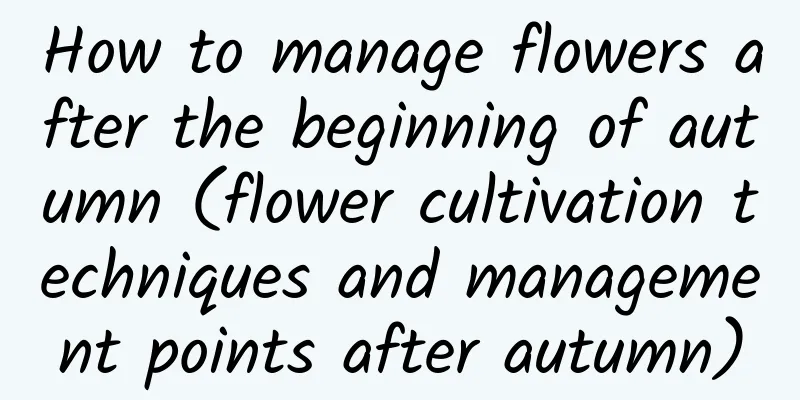How to manage flowers after the beginning of autumn (flower cultivation techniques and management points after autumn)

First, strengthen water and fertilizer management in autumnThe beginning of autumn is the peak period for flower growth, and water and fertilizer management should be strengthened during this period. For flowers with vigorous growth, it is necessary to ensure sufficient water. As the weather turns cooler, plant growth slows down and the demand for water decreases. In addition to the flowers that bloom in autumn and winter or early spring, the amount of watering for other flowers should be reduced to avoid excessive water and fertilizer, which will cause the branches of the plants to grow too long and cause frost damage in winter. The best time to water in autumn is in the morning or afternoon, and the water temperature should be close to that of the soil, which is conducive to root absorption. Large temperature differences can easily cause damage to the roots. Fertilization should be based on different plants and flowers, using different fertilization plans After the weather turns cooler, for some foliage plants, such as asparagus fern, spider plant, cycad, etc., it is generally necessary to apply thin liquid fertilizer or cake fertilizer water every half a month to ensure the branches and leaves are green and improve their ability to resist cold. For flowers that bloom once a year, such as chrysanthemum, camellia, and azalea, it is necessary to apply phosphorus fertilizer in a timely manner to ensure sufficient nutrients and more large flowers. For flowers that bloom multiple times a year, such as roses, Milan, and jasmine, it is necessary to ensure sufficient water and fertilizer so that they can continue to bloom. For some fruit-bearing bonsai, such as kumquat and pomegranate, only 1-2 times of thin liquid fertilizer mainly composed of phosphorus fertilizer is needed in autumn. Second, autumn seed collection and cuttingSome herbaceous flowers will produce seeds in autumn, which is a good time to collect seeds. Flowers whose seeds can be collected in autumn include Impatiens, Zinnia, Mirabilis jalapa, Celosia, Vinca, etc. The collected seeds are threshed, dried, and stored in a dry place for sowing in the spring of the following year. For some one- or two-year-old flowers, such as pansies, dianthus, cineraria, etc., autumn is a good time to sow. Some bulbous flowers, such as tulips, can also be sown in autumn. Perennial flowers such as peonies and peonies can also be propagated by division in autumn. Autumn is also a good season for cuttings. For example, roses, roses, geraniums, jasmine, etc. can all be cut in autumn. Third, autumn pruningAutumn is also a critical period for pruning. Most flowers can be pruned in autumn to maintain the plant shape and avoid excessive consumption of nutrients. Autumn pruning is mainly light pruning. Heavy pruning may weaken the tree and even cause its death. Autumn pruning mainly removes diseased branches, weak branches, dead branches, overcrowded branches and overgrown branches. For plants that bloom in autumn, such as chrysanthemums, some side buds and overcrowded buds should be thinned out during the autumn bud stage to ensure the supply of nutrients. For flowers such as roses, Milan, jasmine, and bougainvillea, pruning is generally done after flowering. Fourth, bring the flowers indoors in time in autumnGenerally, flowers that are not cold-resistant need to be brought indoors in time to keep warm when the weather turns cold in autumn to avoid frostbite. Hibiscus, poinsettia, begonia, cyclamen, monstera, etc. should be brought indoors to keep warm when the temperature is below 10 degrees. Chlorophytum, asparagus fern, Aspidistra, etc. can be brought indoors when the temperature is above 5 degrees. When to bring flowers indoors depends on the temperature and the growth habits of different flowers. Most flowers should be brought indoors before the Descent of Frost. |
<<: How to keep roses alive (how to grow roses easily and well)
Recommend
Cultivation methods and maintenance of old wild azalea piles
How to grow wild azalea into an old pile Old wild...
The growth environment and local conditions of Polygonatum sibiricum
Polygonatum sibiricum growth environment and cond...
What should I do if spots appear on ivy leaves?
Causes of spots In our daily life, the ivy we gro...
How to breed money bag
Cutting propagation of money bag The most common ...
How to propagate creeping bellflower
There are several ways for these plants to reprod...
What are the cultivation methods and precautions of Monstera
Growth habit of Monstera Monstera prefers a semi-...
What is cabbage?
What is cabbage? Cabbage, also known as cabbage, ...
How to cultivate Phalaenopsis chinensis and what to pay attention to
Phalaenopsis growth habits Golden Edge Phalaenops...
The flower language and legend of Saxifrage
The flower language of Saxifrage: persistence The...
When is the best time to top the Kalanchoe (which month is the best time to top the Kalanchoe)
The Kalanchoe is worthy of its name, it is really...
How to grow butterfly flower
1. Soil When caring for Cleome, as long as the so...
Is the yield of girl fruit high? What is the yield per mu?
Is the yield of girl fruit high? If the planting ...
How does Areca palm survive the winter?
How to survive the winter temperature Areca palm ...
How to identify Terminalia terminalia
1. Blades The leaves of Terminalia tamarind are b...
How to plant daisy flowers
1. Planting The best time to plant peony in the s...









